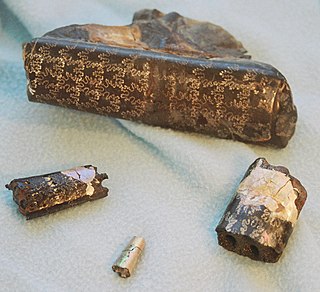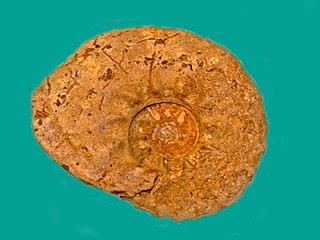
Ammonoids are a group of extinct marine mollusc animals in the subclass Ammonoidea of the class Cephalopoda. These molluscs, commonly referred to as ammonites, are more closely related to living coleoids than they are to shelled nautiloids such as the living Nautilus species. The earliest ammonites appeared during the Devonian, with the last species vanishing during or soon after the Cretaceous–Paleogene extinction event.

Baculites is an extinct genus of heteromorph ammonite cephalopods with almost straight shells. The genus, which lived worldwide throughout most of the Late Cretaceous, and which briefly survived the K-Pg mass extinction event, was named by Lamarck in 1799.

Acanthohoplites is an extinct genus of ammonites in the family Parahoplitidae that lived in the Aptian and Early Albian stages of the Early Cretaceous.

Australiceras is an extinct ammonite genus from the upper part of the Early Cretaceous, Aptian stage, included in the family Ancyloceratidae.

Anapachydiscus is an extinct cephalopod genus from the Upper Cretaceous, Santonian - Maastrichtian of Europe, Africa, Madagascar, S.India, N Z, Calif. Mexico, Argentina, and the Antarctic belonging to the ammonoid family Pachydiscidae.

Barroisiceras is an acanthoceratacean ammonite from the Upper Cretaceous, Coniacian, included in the family Collignoniceratidae.
Beudanticeras is an extinct cephalopod genus from the Late Cretaceous period; Albian and Cenomanian, belonging to the ammonoid subclass and included in the family Desmoceratidae.
Utaturiceras is an upper Cretaceous (Cenomanian) ammonitid belonging to the family Acanthoceratidae and subfamily Mantelliceratinae.

Acanthoceratidae is an extinct family of acanthoceratoid cephalopods in the order Ammonitida, known from the Upper Cretaceous. The type genus is Acanthoceras.

Lytoceratina is a suborder of Jurassic and Cretaceous ammonites that produced loosely coiled, evolute and gyroconic shells in which the sutural element are said to have complex moss-like endings.

Ammonitina comprises a diverse suborder of ammonite cephalopods that lived during the Jurassic and Cretaceous periods of the Mesozoic Era. They are excellent index fossils, and it is often possible to link the rock layer in which they are found to specific geological time periods.

Placenticeras is a genus of ammonites from the Late Cretaceous. Its fossils have been found in Asia, Europe, North and South America.

Prolecanitida is an order of extinct ammonoid cephalopods, the major Late Paleozoic group of ammonoids alongside the order Goniatitida. Prolecanitids had narrow shells, discoidal (disc-shaped) to thinly lenticular (lens-shaped). They retained a retrochoanitic siphuncle, a simple form with septal necks extending backwards. As is typical for ammonoids, the siphuncle sits along the ventral margin of the shell.

Discophyllitidae are discoidal, generally evolute Phylloceratina from the Upper Triassic, derived from the Ussuritidae, in which the principal saddles of the suture have bifurcated or trifurcated endings, described as being di- or triphyllic. Discophyllitid shells are rather similar to those of the ancestral Ussuritidae and are distinguished primarily by the more complex suture. The Discophyllitidae provided the source for the Jurassic Phylloceratidae and Juraphyllitidae. Four genera are recognized and described.

Mammites is a Late Cretaceous ammonite genus included in the acanthoceratoidean family, Acanthoceratidae, and the type genus for the subfamily Mammitinae. Mammites was named by Laube and Bruder in 1887.
Brancoceras is a rather small, strongly ribbed, acanthoceratacean ammonite from the Albian stage of the Lower Cretaceous, the shell evolute with a subquadrate whorl section and rounded venter. The suture forms a finely squiggly line with well-defined lobes and saddles. Brancoceras (Eubrancoceras) aegoceratoides reached a diameter of at least 4.2 centimetres (1.7 in).

Hauericeras is an ammonite genus from the Late Cretaceous that lived from the Coniacian to the late Maastrichtian, from about 90 to 66 mya. Fossils have been found in Europe, Russia, South Africa, Australia, India, Iraq, and in the United States.

Lytoceratinae is a subfamily of ammonoid cephalopods that make up part of the family Lytoceratidae.

Mammitinae comprises a subfamily within the Acanthoceratidae (Ammonoidea) characterized by moderately to very evolute shells with rectangular to squarish whorl sections along with blunt umbilical and prominent inner and outer ventrolateral tubercles on sparse ribs that may be round and strong, sharp and narrow, or absent. The suture is somewhat simpler than that of the Acanthoceratinae. Range is restricted to the lower Turonian stage of the Upper Cretaceous.
Cunningtoniceras is a stocky acanthoceratid ammonite from the upper Cenomanian stage of the late Cretaceous of the western U.S., found e.g. in Arizona and New Mexico.















